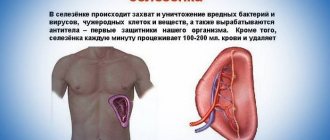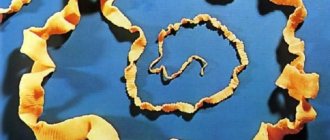Healthy spleen
The spleen is a relatively small organ that is about 11 cm long, 7 cm wide, 4 cm thick and weighs between 150 and 200 g. The spleen is bean-shaped and soft in consistency in both men and women. The color varies between cherry red and blue-violet.
Location of the spleen in the human body
Anatomy and physiology
The spleen is located below the diaphragm in the left upper abdomen: it borders the left kidney and pancreas. With the help of connective tissue it is connected to neighboring organs. On the outside, the spleen is surrounded by a connective tissue capsule that protects it from external influences.
The internal contents of the spleen are called pulp. The pulp is divided into two zones: red and white, they perform different tasks. The spleen is supplied with blood through the splenic artery. Blood flows from it to the liver. Blood is pumped through the spleen about 500 times every day.
- The red pulp consists of venous sinuses, pulp cords and Billrothe. In the pulp, old blood cells are captured and destroyed by macrophages. The spleen converts iron into hemoglobin (the red pigment in the blood). Even small blood clots and “used” platelets are sorted and destroyed in the spleen.
- The white pulp is part of the immune system. Lymphocytes (a certain type of white blood cell) are stored here, which also partially mature in the spleen. About 30% of all leukocytes are stored in the white pulp. Lymphocytes respond to pathogens - bacteria or viruses - that enter the spleen in the blood. When needed, lymphocytes are also released into the blood. In addition, immunoglobulins are formed in the white pulp, which are special antibodies against pathogens.
The spleen always stores a certain amount of blood, which is released, for example, during bleeding or in case of intense physical activity. It is also the site of macrophage production. Monocytes make up to 30% of macrophages, which destroy some bacteria in the spleen.
Normal indicators
Ultrasound determines the shape, position of the organ, size and density of the spleen tissue. Typically, 3 main size indicators are considered: length, width and height. For an adult, 11-12 centimeters in length, 6-8 in width and 4-5 in height are normal. The spleen is normally located approximately in the region of the 9th-11th rib in the left upper quadrant of the abdominal cavity.
What functions does it perform?
The spleen is one of the most mysterious organs of the human body. It is located behind the stomach, in the left hypochondrium, and has the shape of an elongated hemisphere. For a long time it was believed that the spleen performs digestive functions, but modern scientists have proven its relationship to the immune system.
Functions of the spleen:
- formation of red blood cells and lymphocytes
- cleansing the blood of harmful microorganisms
- formation of immunity
- normalization of metabolic processes in the body
In an adult, the length of the spleen is about 8-14 cm and the width is 4-6 cm. Its weight does not exceed 400 g. The organ is covered with a capsule. The place where blood and lymphatic vessels, as well as nerve fibers, enter it is called the hilum. Fixation of the spleen is carried out due to intra-abdominal pressure, which is provided by special ligaments covering the organ on all sides (with the exception of the hilum of the spleen, as well as the place of contact with the tail of the pancreas).
https://youtu.be/zUxeU7XfjZg
Symptoms and types of spleen diseases
One of the most common symptoms of spleen disease is pressure or pain in the left upper abdomen, which may radiate to the fingers of the left hand and left shoulder. Depending on the extent of the splenic rupture or infarction, the abdominal wall may be very sensitive to pain. In severe cases, breathing problems, low blood pressure, rapid heartbeat, shock, cardiac collapse, or cardiac arrest may occur.
If the spleen is ruptured due to trauma, there may be some bruising in the left upper abdomen or rib fractures.
In a car accident, a bruise along the seat belt on the left upper abdomen may indicate severe trauma to the organ.
Common diseases of the spleen:
- Rupture or infarction of the spleen.
- Postsplenectomy syndrome.
- Autoimmune diseases.
- Malignant or benign tumors.
Symptoms of spleen diseases:
- Pain in the upper quadrant of the abdomen.
- Nausea.
- Enlarged spleen.
- Anemia.
- Vomit.
- Dizziness.
- Paleness of the skin.
- Loss of consciousness.
In the International Classification of Diseases, 10th revision (ICD-10), diseases of the spleen are designated by code D73.
Enlarged spleen
An enlarged spleen can be caused by various pathologies.
Splenomegaly is a pathological enlargement of the spleen caused by infectious, hematological or cancerous diseases. The organ is well palpated under the left costal arch if it swells twice. Splenomegaly can be quite painful. An enlarged spleen usually indicates a bacterial, viral or parasitic infection: glandular fever, tuberculosis or malaria.
An overactive immune system also leads to spleen problems. Leukemia, a malignant change in white blood cells, is another cause of splenomegaly. In Gaucher disease, complex lipids are not destroyed, but rather are deposited in organs such as the spleen. Disease of the spleen can lead to a 20-fold increase in the size of the parenchymal organ. Cirrhosis of the liver or heart failure alters the blood flow between the intestines and the liver, so portal hypertension can develop. Excessive blood can enlarge the spleen. This, in turn, leads to an increase in the number of red blood cells.
Splenic rupture
Blunt or sharp trauma from an accident can rupture the spleen. Since the organ is well supplied with blood, injury quickly leads to severe blood loss. Often the cause of blood loss is splenic infarction due to non-traumatic causes - embolism of the splenic vessels or venous stasis. In many cases, surgical hemostasis is the only possible therapy. Sometimes the spleen must be completely removed (splenectomy) to stop internal bleeding.
Postsplenectomy syndrome
People with impaired spleen function (pathology) may experience hypersensitivity to certain bacterial pathogens - pneumococci (the causative agents of pneumonia and meningitis). In rare cases, infection with bacteria leads to sepsis, which is often fatal.
Autoimmune diseases
In an autoimmune disease, antibodies are formed against the body's own cells. Antibodies known as "autoantibodies" cause chronic inflammation in various tissues. As a result, collagenosis develops - systemic lupus erythematosus - in which connective tissue is destroyed, including in the spleen.
In the case of rheumatoid arthritis, autoantibodies primarily destroy cartilage and bone structures. Symptoms of autoimmune spleen disease vary significantly: from morning joint stiffness to pain during exercise. A rheumatologist or immunologist will help identify them.
Symptoms of diseases can vary significantly, but treatment and prevention methods are determined strictly by a doctor.
Anemia
Sickle cell anemia is an inherited hemoglobin disorder. In a particularly severe form (homozygous), only sickle cell hemoglobin is produced. With a slightly milder form (heterozygous), it has a partially normal form. Abnormal hemoglobin clogs small blood vessels and easily gets stuck in the connective tissue network of the spleen, where it is destroyed.
Thalassemia is also a hereditary disease that affects the formation of hemoglobin. As a result, the red pigment in the blood binds less oxygen, so the organs are poorly supplied with oxygen. Deformed red blood cells are more easily stuck in the splenic network and are more likely to be destroyed. In both cases, the spleen is surgically removed to prevent life-threatening consequences.
Tumors
In rare cases, both benign and malignant tumors can form in the spleen and nearby organs. Metastases of other cancers sometimes also migrate to this organ. The causes of the development of malignant diseases of the spleen are not fully understood.
Increase in size
Some people may have an enlarged spleen. Most often this occurs due to the accumulation of toxins in the body. The spleen can become enlarged due to long-term antibiotic treatment. Due to blood stagnation, this organ can also increase in size.
There are characteristic symptoms that indicate that the spleen is enlarged:
- Decreased blood hemoglobin. This can only be found out by taking tests. Since most people ignore getting tested, such a clear sign of trouble most often goes unnoticed.
- Infectious diseases. Frequent infections indicate that a person has a weakened immune system.
- Ulceration of feet, hands. Often ulcers can appear in the mouth.
- Increased heart rate.
- The appearance of bruises on the body, provided that the physical impact on the tissue is minimal.
- Periodic bleeding.
- Increased body temperature.
- Pain on the left side radiating to the back or upper limb.
- Feeling of fullness in the stomach.
Diagnostics
Ultrasound allows you to quickly confirm or refute the presence of bleeding
First, the doctor takes a medical history and performs a physical examination of the heart, lungs, and abdomen. If the patient has been in an accident, it is recommended to exclude external signs of injury or disease of the spleen.
A typical symptom of a rupture is pain in the left shoulder in addition to abdominal pain.
Ultrasound examination is the fastest and easiest way to exclude acute bleeding in the abdominal cavity. If the doctor has doubts, ultrasound should be performed several times. The administration of a contrast agent can increase diagnostic accuracy.
The best method for detecting a splenic rupture is a computed tomography (CT) scan with contrast agent. An excessively bright area on the outside of the vessels may indicate bleeding and rupture. An X-ray or CT scan of the chest can help rule out injury to the ribs.
If spleen disease is suspected, laboratory tests should be performed. In the laboratory, you can evaluate the quantitative and qualitative composition of blood (hemoglobin, hematocrit, number of blood cells). Based on an accurate diagnosis, the severity of the splenic rupture can be assessed. This helps plan treatment and prognosis.
Diagnostic procedures
Syndromes and other pathologies of the spleen can be treated only after research due to the almost complete absence of symptoms. Methods of diagnostic procedures:
- taking anamnesis;
- visual inspection;
- Ultrasound;
- palpation (especially informative in asthenic women);
- X-ray examination;
- biopsy and biopsy histology;
- biochemistry;
- general blood test (thanks to a general analysis, a decrease in the level of platelets, red blood cells and leukocytes can be traced);
- computed tomography, etc.
https://youtu.be/yDYWAOgLQTw
Treatment
If a heart attack or rupture of the spleen occurs, it is necessary to stabilize the patient's condition by administering fluids and medications through a vein. A blood transfusion may also be required depending on test results.
There are 4 degrees of splenic rupture:
- Local rupture of the capsule or bruise under it.
- Rupture of the capsule and tissues (except for large vessels).
- Deep fissures that also affect the large vessels of the spleen.
- Complete rupture of the spleen.
After the initial examination, a decision must be made about the need for emergency surgery. The more severe the injury, the sooner surgery is required. Even if the doctor suspects hemorrhage in the abdomen and the circulation is unstable, emergency surgery is performed. The correct and quick choice of methods for treating spleen diseases is an important step.
For autoimmune and other diseases, treatment will depend on the underlying cause. The use of immunosuppressants, hematopoietic drugs or minimally invasive interventions may be required.
Conservative treatment
If surgery is not required, the patient must remain in the hospital, including in the intensive care unit. Especially in the first 24 hours after entering the department, strict bed rest must be observed. Circulatory parameters (such as blood pressure and heart rate) are monitored using a monitor. In addition, careful blood tests and ultrasound examinations should be performed, depending on the severity of the injury. In many cases, the risk of serious complications is significantly reduced after 72 hours.
The treatment regimen depends on the type of disease, therapy is carried out in a hospital setting
Operation
There are many different surgical techniques for splenic rupture. The most radical measure is to remove the entire organ (splenectomy). The condition without a spleen is called asplenia. Splenectomy is currently performed exclusively for severe bleeding in the abdominal cavity and other signs of spleen disease.
In other cases, only part of the organ can be removed (resection) or vascular occlusion in the affected area can be targeted. The latter is performed using suture, glue, electrical or other hemostatic method (for example, thermal coagulation). After this, the patient must stay in the hospital for about 10 days.
It is now also possible to occlude individual vessels of the spleen with a catheter inserted into the inguinal veins (embolization) to stop bleeding. Regular follow-up examinations are decisive for the postoperative course. Some patients may experience abdominal pain for several weeks after surgery. Although the spleen is not a vital organ, complete removal carries certain risks. Because the spleen helps in protecting the body from pathogens, people who undergo splenectomy are at increased risk of developing infectious diseases.
Any abdominal surgery carries common risks. In addition to injury to other abdominal organs, bleeding, infection, allergic reactions, pancreatitis, and portal vein thrombosis may occur. Other possible complications include pseudocysts, abscesses, and arteriovenous shunts (abnormal connections between an artery and a vein).
Living without a spleen is associated with an increased risk of developing infectious diseases. For this reason, people should be vaccinated regularly (especially against pneumococci, meningococci and Haemophilus influenzae). In case of fever, patients should consult a doctor quickly. Long-term antibiotic prophylaxis against bacterial infections should be used only in children.
Some patients may experience postsplenectomy syndrome, which leads to serious blood poisoning. Toddlers and children without a spleen, especially, are at greater risk of developing a severe infection. This form of sepsis usually occurs in the first years after splenectomy. The main causes of systemic infection are pneumococci, meningococci, staphylococci, and strains of Escherichia coli.
In the first 3 months after removal of the spleen, the platelet count increases to critical values. Therefore, treatment with acetylsalicylic acid (as well as heparin) is recommended to reduce the risk of thrombosis due to a large number of platelets.
If pain occurs in the upper quadrant of the abdomen or left shoulder, it is recommended to immediately seek medical help.
Prevention
A healthy lifestyle will help to avoid problems with the spleen: a balanced diet, regular exercise. The body must receive a sufficient amount of nutrients, especially copper, in the form of vitamin complexes.
Other recommendations:
- avoid bruises and wounds in the abdominal area
- drink enough water to cleanse the body, in particular the spleen
- give up alcohol, especially low-quality alcohol
- Conduct regular preventive examinations and laboratory blood tests
- wear loose clothing that does not cause discomfort while moving
The diet of patients suffering from spleen diseases must contain a sufficient amount of nuts, beef liver, and fish. It is recommended to eat carrots and beets as vegetables. Timely treatment of any diseases, including infectious ones, will avoid the development of complications in the form of disruption of the spleen. It is also necessary to examine injuries and bruises of the torso, in particular those resulting from fights and falls.
Forecast
Decisive for the prognosis for all diseases of the spleen is early diagnosis and correct therapy. The vast majority of spleen diseases can be treated without surgery. More than 90% of diseases in children can be treated without surgery.
If only part of the spleen is removed, the remaining tissue can completely “take over” the function of the removed one. In 4% of cases, patients develop sepsis. Life-threatening effects usually occur within the first 24 to 72 hours. About 80% of patients with a ruptured spleen recover within 7-10 weeks.
Related Articles
What is lymphoma: symptoms, treatment methods and prognosis
Enlarged spleen: what does it mean and what is the reason?
Lymphadenitis: causes, signs and treatment methods
Inflammation of the spleen: features of the disease, causes and treatment methods
Lymph node under the arm: location and functions, causes of inflammation
How to treat lymph nodes in the neck: what medications are used?
How classical music affects the problem
Music can enhance any joy, eliminate sadness, illness, and manifestations of inflammation. Even in the last century, it was noted that it affects the spirituality, intelligence and physical condition of a person.
Analyzing the data from recent studies and observations, we can confidently say that listening to classical music leads to a decrease in pain intensity and an increase in the effect of painkillers.
Thanks to this method of therapy, brain-derived neurotrophic factor is stimulated, which is responsible for the growth of neurons endowed with the ability to improve health.
Brain scans of musicians have found that sounds activate some of the same brain reward systems that are activated by tasty foods, proximity, and even drugs.











